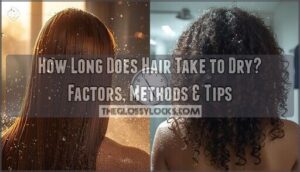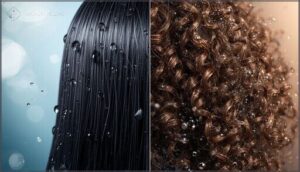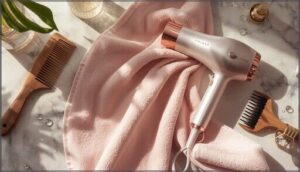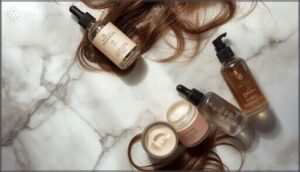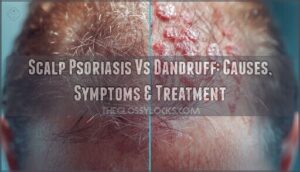This site is supported by our readers. We may earn a commission, at no cost to you, if you purchase through links.
Your hair’s dripping wet, you’ve got somewhere to be in an hour, and you’re staring down a decision: grab the blow dryer or let nature take its course? Most people underestimate just how wildly drying times vary—straight hair might air dry in 45 minutes while thick curls can stay damp for three hours or more. The truth is, there’s no universal clock ticking down your wet strands.
Texture, porosity, length, humidity, even the towel you grab—they all conspire to either speed things up or drag them out. Understanding what’s actually happening when water evaporates from your hair puts you back in control, whether you’re racing against time or protecting your strands from heat damage.
Table Of Contents
- Key Takeaways
- How Long Does It Take for Hair to Dry?
- Factors That Affect Hair Drying Time
- How Hair Texture Influences Drying
- Drying Methods: Air Drying Vs. Blow Drying
- The Role of Towels and Tools in Drying
- Impact of Hair Products on Drying Time
- Environmental Factors Slowing or Speeding Drying
- Tips to Make Hair Dry Faster
- Frequently Asked Questions (FAQs)
- Conclusion
Key Takeaways
- Hair drying time ranges from 20 minutes for short fine hair to over 4 hours for dense curly hair, with texture, porosity, and length creating wildly different timelines that you can’t ignore.
- Your hair’s porosity—whether cuticles are tightly sealed or full of gaps—controls how fast water escapes, meaning low porosity hair dries faster once wet while high porosity hair holds moisture longer.
- Switching from cotton to microfiber towels cuts residual dampness by 30-60% and removes way more water without roughing up your cuticles or adding frizz.
- Blow drying slashes your wait time by up to 70% compared to air drying, but you’ll risk heat damage if you skip protectants or crank temperatures past 140°F.
How Long Does It Take for Hair to Dry?
There’s no one-size-fits-all answer regarding how long your hair takes to dry. The timeline shifts based on your drying method, hair type, and even the room you’re in.
Let’s break down the basic time ranges so you know what to expect.
If you have low porosity hair, you’ll need extra patience during deep conditioning—check out these specially formulated deep conditioners for low porosity hair that help penetrate those tightly sealed cuticles.
Average Air Drying Times
Air drying time hinges on your hair’s unique blueprint—texture, density, and porosity all play a role. Here’s what you can expect:
- Short hair usually air dries in 20 to 40 minutes with decent air circulation.
- Medium-length hair needs 45 to 90 minutes under normal moisture levels.
- Long hair demands 2 to 4 hours for complete drying.
- Dense, curly hair may exceed 4 hours in low-ventilation spaces.
- Damp-to-dry shift generally occurs within 60 to 120 minutes for shoulder-length hair.
Typical Blow Drying Times
Switching to heat cuts your wait time dramatically. Thin, fine hair often dries in 5 to 15 minutes with a blow dryer on medium heat. Thicker, longer strands need 20 to 45 minutes, especially if you’re using drying techniques like a concentrator nozzle. Hair dryer types and heat control matter—salon-grade styling tools can finish the job in 15 to 30 minutes, depending on your texture and desired smoothness.
| Hair Type | Blow Dry Settings | Typical Drying Time |
|---|---|---|
| Fine, thin | Low to medium heat | 5–15 minutes |
| Medium, straight | Medium heat | 10–20 minutes |
| Thick, coarse | Medium to high heat | 20–45 minutes |
| Curly with diffuser | Low to medium heat | 20–40 minutes |
| Long, dense | Medium heat, sectioned | 30–45 minutes |
Wetness Assessment by Touch
Once you’ve blow-dried, your fingers become your best tool for checking dryness. Run them gently through different sections to gauge moisture levels—you’re looking for tactile feedback that tells you when you’ve hit the dryness threshold. Here’s what to feel for:
If you’re rushing through your routine, shaving your legs in the shower requires similar attention to moisture levels before you start.
- Slippery texture means water’s still clinging to the surface
- Increased hair stiffness signals you’re getting close
- No visible dampness confirms you’re done
Hair porosity and hair texture create different surface textures, so trust the touch test across multiple sections for accurate drying time assessment.
For a detailed breakdown of how banding time shifts with section thickness and product choice, these variables matter just as much as porosity.
Factors That Affect Hair Drying Time
Not all hair dries at the same speed, and you’re not imagining things if yours seems to take forever. A few key factors control how long you’ll be waiting around with damp strands.
Let’s break down what’s actually slowing you down or speeding things up.
Hair Texture and Type
Your hair texture and type aren’t just about how your strands look—they’re major players in hair drying time. Fine hair dries faster than thick or coarse hair due to hair density and cuticle structure. Straight hair beats curly and coily textures every time because those tight curl patterns lift the cuticle and trap moisture.
Coily and curly types also need specialized styling techniques for different textures to keep moisture locked in while drying.
Understanding your texture analysis helps you work with your hair, not against it.
Hair Porosity
Porosity tests reveal how your hair manages moisture—and that changes everything about drying time. High porosity hair has gaps in the cuticle that let water in and out fast, while low porosity hair keeps moisture locked in longer. Here’s what you need to know:
Pairing a microfiber towel with your porosity type speeds up drying without the frizz—check out the best techniques for air-drying and towel-drying hair to see how it works.
- High porosity equals faster water absorption and quicker evaporation
- Low porosity means tightly sealed cuticles and slower drying
- Chemical treatments and heat styling directly impact your hair’s porosity level
- Simple strand tests help you figure out your hair type and adjust your routine
Hair Length and Thickness
The sheer volume of your strands dictates how long you’re stuck waiting. Thick hair holds way more water than fine hair, so drying rates slow down considerably.
Hair length below your shoulders can add 20–40% more drying time compared to shorter cuts. Dense hair blocks airflow between sections, trapping moisture levels longer—meaning you’ll need targeted hair drying techniques to speed things up.
How Hair Texture Influences Drying
Your hair’s texture doesn’t just affect how it looks—it actually changes how long it takes to dry. Straight and wavy hair behave differently than curly or coily types, and porosity plays a bigger role than most people realize.
Here’s what you need to know about how your specific texture affects drying time.
Straight Vs. Wavy Hair
You’ve probably noticed that not all hair behaves the same way when it’s wet. Straight hair usually dries faster than wavy hair because it has a smoother hair cuticle and less surface area that traps moisture. Here’s what affects drying rates between these hair types:
- Wave patterns create more surface roughness, slowing moisture evaporation and extending drying time
- Straight hair shows uniform moisture loss, reaching 70–80% dryness quicker in the first 15 minutes
- Frizz control products on wavy hair can seal the cuticle, holding in moisture levels longer
The difference becomes even more noticeable in humid conditions, where wavy textures retain dampness while straight hair reaches manageable dryness faster. Understanding your hair type helps you choose the right hair drying techniques for better hair health.
Curly and Coily Hair
If you’re rocking curls or coils, you’re looking at 1.5 to 2 times longer drying time than your straight-haired friends. Curly hair care requires patience because those gorgeous spiral patterns trap water deep in the core.
Hair diffusion methods with a hooded dryer can cut your wait, while curl definition products help manage moisture retention strategies.
Coily texture tips start with understanding your hair porosity—it’s your secret weapon for faster drying.
Porosity and Moisture Retention
Think of your hair cuticle integrity like shingles on a roof—when they’re tight, water slides off fast. Hair porosity determines your water absorption rate and moisture balance, making it vital for hair drying speed and hair health.
Your hair’s porosity works like roof shingles—tight cuticles shed water fast, while open ones hold moisture longer
Here’s what you need to know:
- Low porosity hair repels moisture initially but dries faster once wet
- High porosity hair soaks up water quickly and holds it longer
- Porosity tests help you understand your hair hydration needs
- Moisture retention affects your overall hair texture and styling time
Drying Methods: Air Drying Vs. Blow Drying
You’ve got two main ways to dry your hair, and each one comes with its own set of trade-offs. Air drying gives you a hands-off approach, while blow drying puts you in the driver’s seat with speed and control.
Let’s break down what works best for different situations so you can make the call that fits your routine.
Pros and Cons of Air Drying
Air drying your hair is a trade-off worth understanding. You’ll slash heat damage risk and preserve your natural texture without using extra energy. The catch? Expect longer drying times—sometimes hours instead of minutes. High humidity can trigger frizz for certain hair types, so moisture balance matters. Your hair texture plays a big role in how well this method works for you.
| Benefit | Challenge | Best For |
|---|---|---|
| Zero heat damage | Extended drying time | Fine to medium hair |
| Maintains natural texture | Potential frizz buildup | Low-humidity climates |
| Energy savings | Less control over style | Wavy or curly patterns |
| Gentler on strands | Discomfort when damp | Healthy, undamaged hair |
| Preserves moisture balance | Requires patience | Air-dry enthusiasts |
Pros and Cons of Blow Drying
Blow drying flips the script—you’ll cut drying time by up to 70% and gain serious styling control. An ionic hair dryer reduces frizz while concentrating airflow where you need it. The downside? Heat damage becomes real if you’re skipping protectants or cranking temperatures past 140°F. Energy consumption adds up, and repeated high-heat sessions can dull your shine over six months.
| Advantage | Drawback |
|---|---|
| Faster drying efficiency (10–15 minutes) | Risk of heat damage without protection |
| Precision styling with round brushes | Higher energy consumption (1,200–1,800 watts) |
| Reduced frizz with ionic technology | Natural shine decreases with frequent high heat |
When to Use Each Method
Knowing when to switch methods changes everything. Your hair’s needs shift based on damage levels, time constraints, and styling goals. Fine or compromised strands thrive with air drying to avoid further stress. When you’re rushing out the door or need volume, blow drying with medium heat and a nozzle wins.
| Situation | Best Method |
|---|---|
| Damaged or fine hair | Air dry with minimal product |
| Quick styling needed | Blow dry on medium heat settings |
| High humidity days | Blow dry to control frizz |
| Overnight preparation | Air dry while sleeping |
The Role of Towels and Tools in Drying
The tools you reach for after a shower matter more than you might think. A regular cotton towel can actually slow down your drying time and create frizz you don’t need.
Let’s look at the right towels and tools that’ll speed things up and keep your hair healthier.
Microfiber Vs. Cotton Towels
Your towel choice makes a real difference in drying time. Microfiber towels absorb more water per weight than cotton, cutting residual dampness by 30–60%. Their split-fiber structure creates microchannels that pull moisture away fast.
Cotton towels trap air between fibers, slowing absorption and leaving hair wetter longer. For quicker results, reach for microfiber—it’s the fabric absorbency champion.
Understanding language patterns can also help in describing the benefits of microfiber towels.
Using Wide-Tooth Combs
Once you’ve squeezed out excess water, grab a wide-tooth comb—it’s your best friend for detangling without the drama. Here’s why it works:
- 8–12 evenly spaced teeth glide through without snagging
- Reduces tugging and breakage by distributing tension
- Minimizes frizz with less friction than fine-tooth combs
- Limits split ends by reducing mechanical stress
- Works across all hair types without forcing strands
Gentle styling means healthier hair and faster drying—no wrestling required.
Towel Turbans and Paper Towels
After combing, wrap your hair in a microfiber towel turban—it pulls moisture from roots and mid-lengths without the tug. Microfiber benefits are real: it removes 50-70% more water than cotton, boosting absorbency rates and drying efficacy.
Skip paper towels for hair drying—they’re less effective and can rough up cuticles. Smart towel materials and turban techniques mean faster results and healthier strands.
Impact of Hair Products on Drying Time
The products you put in your hair don’t just style it—they can also seriously change how long it takes to dry. Heavy conditioners, leave-ins, and styling creams create a moisture barrier that slows evaporation, while other products can actually speed things up.
Here’s what you need to know about how your hair products affect drying time.
Heavy Conditioners and Styling Products
Heavy conditioners and styling products can sabotage your drying time by forming a cuticle barrier that traps moisture retention inside each strand. Here’s how product buildup slows things down:
- Silicone-heavy conditioners create film-forming layers that lock water in
- Leave-in styling products add extra weight and moisture content
- Deep conditioning treatments require more evaporation time
- Residual hair care products prevent airflow from reaching the hair shaft
These hair care and maintenance choices directly impact hair drying and styling efficiency while supporting hair damage prevention.
Rinsing Techniques for Faster Drying
After washing, your rinse water temperature sets the stage for faster hair drying. Cooler rinses seal the hair cuticle, reducing frizz and moisture retention compared to hot water that causes swelling.
Biobased rinsing with lukewarm water balances thorough conditioner removal with cuticle smoothness. For your hair type, finish with a cool blast, then gently squeeze excess water into a microfiber towel—this simple shift improves drying time noticeably.
Quick-Dry Sprays and Heat Protectants
Quick-dry spray and heat protectant formulas cut your drying time by creating a moisture-managing barrier on each strand. Here’s what actually works:
- Barrier technology reduces moisture loss by 15–30 percent during heat styling
- Alcohol-free variants prevent extra cuticle dryness
- Light mist application from 6–12 inches avoids buildup
- Higher porosity hair benefits most from the protective film during blow drying
Environmental Factors Slowing or Speeding Drying
Your environment doesn’t just sit there quietly—it actively works for or against you when you’re trying to dry your hair. Temperature, humidity, and airflow can shave off minutes or tack on an extra hour without you realizing it.
Let’s break down how these factors play out and what you can do to take control.
Humidity and Temperature
Think of humidity and temperature as a tag team working against you. High humidity levels slow evaporation rates because the air’s already saturated—boosting it by 10% can add several minutes to your drying time.
Temperature effects matter too: warmer air accelerates moisture loss, while cooler temps hold you hostage. These climate adjustments directly impact hair drying, regardless of your hair type or hair health.
Airflow and Ventilation
You can’t beat good airflow when you want hair to dry faster—it’s the unsung hero of drying efficiency. Here’s how ventilation systems and air exchange transform your drying time:
- Directional airflow parallel to your hair shaft cuts stagnant pockets at the roots, boosting evaporation rate
- Steady airflow speed around 2–3 m/s shortens moisture removal by 15–30 percent versus still air
- Room ventilation with 0.5–1.0 air changes per hour visibly speeds drying for all hair types
Just don’t crank it past 5 m/s—you’ll trade speed for frizz.
Adjusting to Different Climates
Climate adaptation matters more than you think—hair drying time swings wildly when you relocate. Humidity control becomes your best friend in muggy regions where evaporation slows to a crawl, while dry climates let moisture escape fast.
Regional variations in temperature effects and airflow management mean you’ll adjust your routine based on hair type and porosity. Master these shifts and you’ll keep drying time predictable no matter where you land.
Tips to Make Hair Dry Faster
You don’t have to sit around waiting for your hair to dry if you know a few pro tricks. Small changes in how you prep and handle your hair can cut drying time considerably.
Let’s walk through the most effective strategies to get you out the door faster.
Sectioning Hair for Efficient Drying
Dividing your hair into four to six vertical sections isn’t just salon talk—it’s how pros cut drying time. Sectioning techniques with hair clips give you root lift and expose every strand to airflow, which matters whether you’re dealing with hair thickness or tricky hair porosity.
Even distribution of heat means faster, more consistent drying. Vertical parting keeps adjacent sections from rewetting each other.
Removing Excess Water Effectively
Once you’ve sectioned, it’s time to deal with all that water. Blotting with a microfiber towel pulls out 50–70% of surface moisture without the frizz that cotton causes. Gentle blotting respects your cuticle and shaves 30–50% off your overall drying time. Pat, don’t rub—water absorption works best when you’re not fighting friction.
Master these drying techniques and reclaim your morning:
- Microfiber towel wins every time – Cotton roughed you up for years; microfiber benefits include faster water absorption and zero damage
- Wrap it up in a towel turban – Let it work while you handle everything else, cutting hair drying time by 10–20%
- Pat like you mean it – Gentle blotting protects each strand while removing maximum water
- Ditch the rubbing habit – Aggressive towel materials wreck your cuticle and add time instead of saving it
- Test your towel’s real power – Quality microfiber feels like control, not compromise
Choosing The Right Drying Settings and Products
Your dryer settings shape everything. Medium heat with moderate airflow control cuts drying time without frying your hair, while a cool shot at the end locks in smoothness. Product selection matters—heat protection shields every strand, and a diffuser benefits curls by spreading airflow gently. These drying techniques turn your hair dryer into precision control, not guesswork.
| Heat Settings | Airflow Control | Product Selection |
|---|---|---|
| Medium heat speeds drying | Moderate speed reduces frizz | Heat protectant shields cuticle |
| Cool shot sets style | Diffuser spreads airflow evenly | Quick-dry spray cuts minutes |
| Warm range minimizes damage | Low speed for delicate textures | Light products prevent buildup |
Frequently Asked Questions (FAQs)
Does hair drying damage hair cuticles permanently?
Heat can lift cuticles and cause micro-damage when it exceeds your hair’s tolerance.
Using heat protectants and lower temperatures helps prevent permanent deformation, breakage, and moisture imbalance that threaten hair health long-term.
Can diet affect how fast hair dries?
Your diet doesn’t speed up hair drying directly. Hydration levels and dietary balance support hair health and moisture retention over time, but nutrient effects won’t change how fast water evaporates from your strands today.
Understanding scientific study methods is essential for analyzing the impact of various factors on hair drying.
Why does colored hair dry differently naturally?
Color damage from dye opens up the cuticle, boosting porosity and moisture dynamics.
Those structural changes mean pigment effects alter how water clings to strands, slowing evaporation and extending natural drying time noticeably.
Do hair masks slow down drying time significantly?
Yes, hair masks can extend drying time by 10 to 30 minutes. Heavy oils and butters trap moisture, while silicone-rich formulas create a barrier that slows evaporation—especially on longer, thicker hair.
Should you sleep with wet hair overnight?
It’s best to avoid it. Sleeping with wet hair raises your risk of breakage and scalp irritation—overnight damage you don’t want. Dry at least partially before bed for healthier hair.
Conclusion
Drying your hair is a race where slowing down sometimes gets you there faster. The answer to how long does it take for hair to dry isn’t locked in a stopwatch—it’s shaped by your choices, your hair’s quirks, and the tools you trust.
Whether you’re chasing speed or softness, knowing your texture and routine lets you take charge. The next time you towel off, remember: every strand is a small experiment, and you’re the one running the show.

